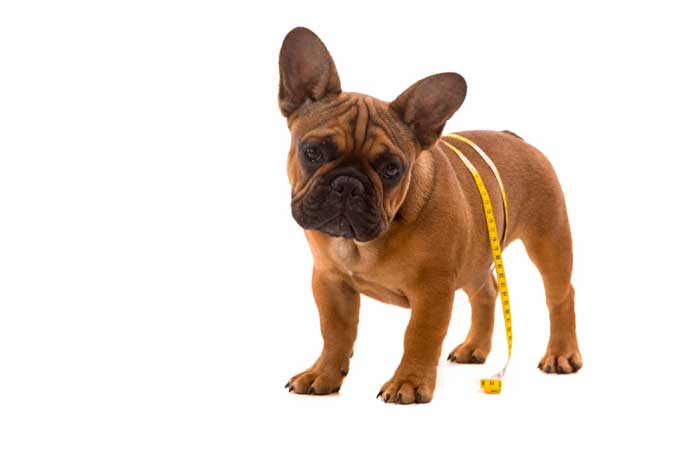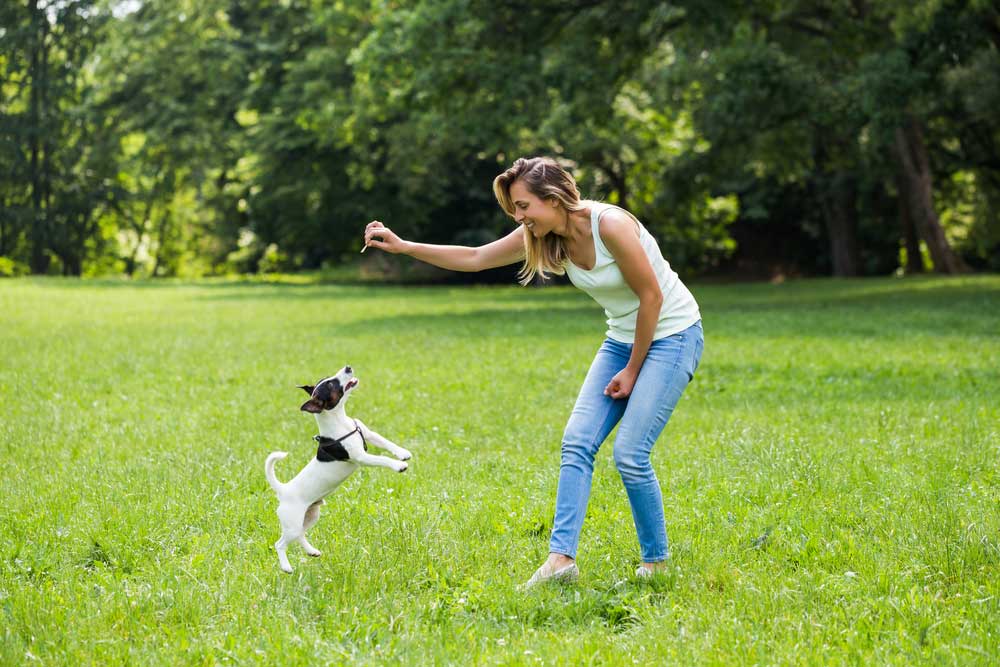The transition into dog parenthood is a tough one, but the reward is getting to watch your new best friend grow up into a bright-eyed and rambunctious tyke.
However, not all pups grow at the same rate. Depending on their age, health, vaccination and neutering status, diet, feeding routine, and daily routine, some dogs take longer to grow into their harness than others. You could stuff them with the best puppy food, but they’ll grow in their own time.
Moreover, not all “healthy” pups look the same, either. Some breeds are naturally very skinny, and it shows as early as their puppyhood.
So, it’s always better to double-check whether your puppy really falls below the average weight. If that does turn out to be the case, the next step is understanding why your puppy isn’t gaining weight. Lastly, you need to devise a game plan around the following considerations:
- What should you be feeding your puppy? What counts as “healthy puppy food?”
- How much food to feed a puppy to help her pack the pounds?
- How frequently should you fill up their bowls?
- When to switch puppy to adult food?
So, let’s get the first task out of the way: confirming your pup’s weight status.
How to Know if Your Puppy is Underweight
As a dog parent, learning about your pup’s anatomy is something that will prove very useful, time and time again. Apart from knowing your fur baby’s teething age or when they reach sexual maturity, recognizing their weight status is just as crucial for their wellbeing.
Sometimes, a visible rib cage could point to some underlying health condition. Or, it could just be a sign that you need to modify your pup’s diet.
Then again, a visible rib cage isn’t always bad news. Some breeds are just naturally skinnier than others, such as Greyhounds, Whippets, Ibizan Hounds, and Kanni dogs, and it’s natural for the last two ribs to show up a bit. Any more than that, though, and they’re definitely underweight.
Moreover, the hip bones or pelvic lines are only visible when the puppy is severely underweight. While some older dogs do have a visible hip bone, keep in mind that puppies carry some extra “baby fat.” Hence, you should expect them to be a little plump than their older counterparts.
If you have access to your pup’s littermates, you can also use their size and weight as a reference to determine whether yours is on the right track.
And if all else fails, you can always check with your vet to see whether your puppy needs to put on some weight.
Reasons Why Your Puppy Might be Underweight
If your puppy is underweight, one of two things has happened:
- She is eating enthusiastically but isn’t putting on weight. This comes down to an imbalanced diet, underfeeding, over-exercising, or putting her on the wrong diet.
- She isn’t eating as much as she should. This could be because she’s anxious, picky, under the weather, or experiencing health problems.
Some other reasons why your puppy is underweight could include:
- Parasites — intestinal parasites like hookworms, roundworms, and tapeworms are extremely common in puppies, and weight loss is a typical symptom.
- Parvo — until their first vaccination course finishes, puppies are highly susceptible to a gastrointestinal disease called parvo. Loss of appetite, bloating, abdominal pains, vomiting, diarrhea, and weight loss are common symptoms.
- Liver shunt — this is a condition that affects the liver— the primary organ of metabolism. The foremost symptom of liver shunt is stunted growth.
- Not enough calories — the answer to your pup’s scrawny appearance could just be as simple as you’re not feeding them enough.
- Wrong diet — puppy diets are pretty diverse, including raw, cooked, dry, wet, homemade, mixture, etc. Maybe your picky eater just can’t stomach the diet that you chose for her.
- The runt of the litter — in larger litters, one or two puppies always lag in growth because everyone is fighting for a spot at mum’s open bar. It can take them up to 2 months to recover from this early malnutrition.
- Weaned too early — the ideal age to fully wean puppies is around 7 to 8 weeks. If they’re cut off from their mother’s milk any sooner than that, they may face trouble putting on weight. This is why it’s important to make sure you’re dealing with a responsible breeder who won’t separate the puppies from their mother prematurely.
- Irregular dental development — pups with dental problems may find it too difficult to eat hard, dry kibble.
Always Consult Your Vet to Pinpoint the Cause
Since there are so many health-related reasons that your puppy might be underweight, you should always get your pup a thorough checkup from the professionals.
A medical checkup could reveal a serious health condition like parvo, liver shunt, or parasites, which require separate, non-diet-related treatments.
Moreover, it will save you from mistreating your pup. For example, you could risk overfeeding her when the problem isn’t that she doesn’t get enough food, but rather that she can’t keep it down because of a health condition.
If the true cause turns out to be some health condition, you might not have to do much to your pup’s diet and just wait for the treatment to run its course.
5 Ways to Help Your Puppy Gain Weight
So far, we’ve dealt with the first two phases of catering to an underweight pup. We have confirmed her weight status and ruled out any possible health conditions that may be holding back her weight.
Now, it’s in your hands to make some changes to your puppy’s diet, feeding schedule, and eating patterns. Here are some ideas.
-
Increase Their Calories
The first thing to try is to slowly increase your pup’s food intake by a quarter of a cup every few days. Increasing their calories is important, but it should be a gradual transition.
Sometimes, though, it’s not a question of how much to feed a puppy in terms of volume, but rather in terms of calorific value.
This is particularly helpful if your pup is a picky eater or suffers from a low appetite. By using calorie-rich food, you will ensure your puppy gets enough calories even if she doesn’t lick her bowl clean.
The best puppy food for high calories is one that is specifically labeled for growth or recovery, such as Royal Canin Recovery Food.
-
Increase Frequency, Decrease Volume
An effective way to increase your pup’s overall caloric consumption is by increasing the frequency of meals while decreasing the serving for each meal. In other words, you can distribute their meals throughout the day.
By doing so, you will prevent your puppy’s discomfort from eating too much all at once.
-
Switch Their Puppy Food Brand
Not all food brands agree the same with all pups. It could be possible that you’re stuffing your puppy with a brand that doesn’t suit them, whether it’s because of the food texture, size, or nutritional content.
In this case, try switching up your go-to brand of puppy food. Here are some of the best puppy food brands for puppies with special nutritional needs:
- Blue Buffalo Puppy Food
- Royal Canine Puppy food
- Purina Puppy Food
- Science Diet Puppy Food
Determining which brand works for your fur baby is a game of trial and error, carefully tracking your pup’s weight fluctuations, and tons of patience. Give each brand at least two weeks before switching to the next.
-
Use Slow Feeders
Puppies who inhale their food are likely to suffer from a host of gastrointestinal problems. In turn, these gastrointestinal problems hinder your pup’s ability to digest their food properly.
To nip this problem in the bud, see whether your pup responds well to slow feeders. Although it seems counterintuitive, slow feeders are just as beneficial for underweight puppies as they are for overgrown Fidos as they prevent gastrointestinal problems.
-
Stimulate Their Appetite
If your puppy doesn’t wag their tails in excitement over a plate of fresh grub, it could be because they aren’t in the mood to eat. While once or twice is no big deal, persistent aversion towards food could reflect unmet physical, mental, or emotional needs.
Hence, make sure your puppy is receiving ample attention and playtime so that she can work up a huge appetite for dinner. Be careful not to overwork your puppy, though; she shouldn’t exercise more than what she can make up for with a high-calorie, nutritional meal.
What Not to do While Helping Your Puppy Gain Weight
Here are some things to avoid while helping your underweight put on some weight:
- Don’t start giving any supplements unless your vet suggests it.
- Don’t suddenly introduce new changes to their diet, whether it’s food texture or volume. Any changes to a puppy’s diet should be a gradual process.
- Don’t switch them to adult dog food too early. Puppy food is much more calorie-dense than adult dog food and also contains some vital nutrients absent in adult dog food.
- Don’t lessen their playtime or exercising time.
Conclusion
It’s difficult to imagine a puppy that isn’t round, chunky, and plump. It’s even worse when you’re faced with an underweight pup, unsure of how to help them gain weight.
The best recourse is to consult with your vet before taking appropriate action. Depending on the reason behind your puppy’s low weight, you can either increase their food intake, change their diet, or try to stimulate their appetite.
Within a matter of weeks, your pup will be as round, chunky, and plump as she should be.


